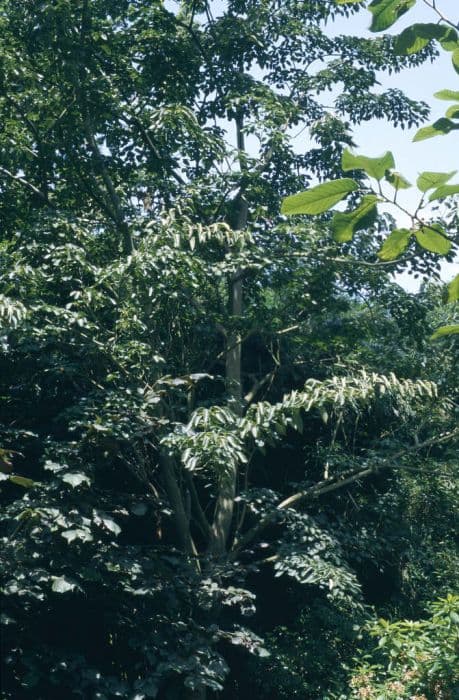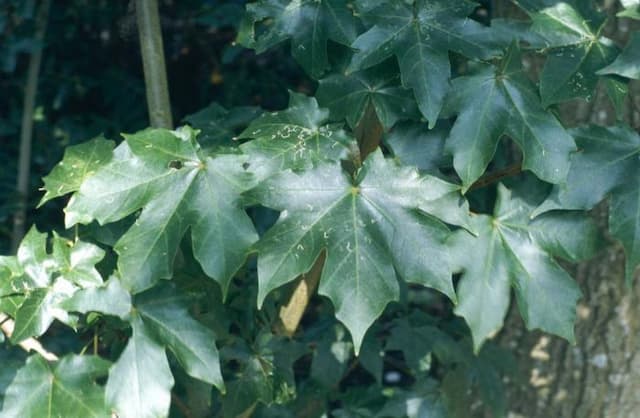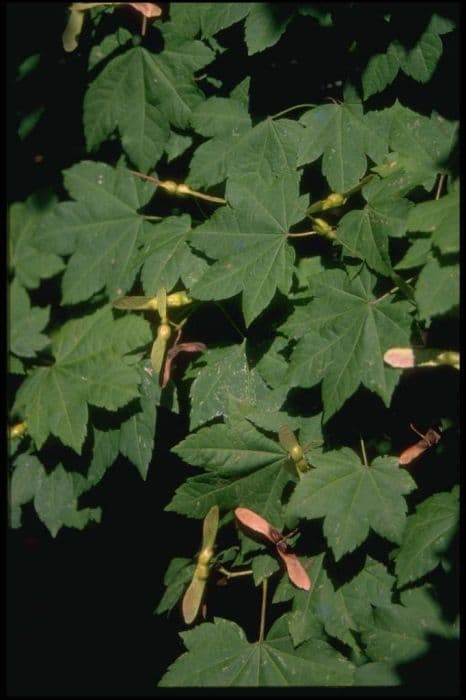Autumn Blaze Maple Acer × freemanii Autumn Blaze = 'Jeffersred'
![Freeman maple [Autumn Blaze]](/_next/image?url=https%3A%2F%2Fplants-admin.emdemapps.com%2Fimages%2Fplants%2F%2Fimages%2F604b575b84d87.png&w=3840&q=75)
ABOUT
The Autumn Blaze Maple is known for its striking and vivid appearance which prominently features a vibrant mix of orange and red hues that resemble a blazing flame during the fall, truly living up to its name. This hybrid plant is a cross, combining the best traits of its parent species, such as the strong branch structure and the exceptional fall color. During spring and summer, the leaves of the Autumn Blaze Maple are a fresh, bright green, providing a cooling canopy of dense foliage. The leaves themselves are star-shaped, typically with five pointed lobes, although occasionally some may have slightly more. These lobes taper sharply, giving the leaves a somewhat jagged, yet graceful appearance. The margins of the leaves are finely serrated or toothed, providing a delicate texture up close. As the seasons change, the leaves undergo a dramatic transformation, turning from their summery green to shades of luminous orange and red, making it a standout among autumn landscapes. The bark of the Autumn Blaze Maple is smooth and silvery gray when the tree is young, gradually becoming more ridged and furrowed with age, adding to the tree's character over time. This maple variety forms a rounded to broadly oval shape canopy, contributing to its well-regarded status as an ornamental tree. Its appealing shape and the year-round interest it provides, from the fresh greens of spring to the fiery foliage of autumn, make it a favored choice for home landscapes, parks, and street plantings. The Autumn Blaze Maple has a robust and fibrous root system, allowing it to establish itself firmly and making it a resilient choice for a wide range of environments. Flowers and fruit are typically inconspicuous on the Autumn Blaze Maple. Its flowers are small, and not particularly showy, and the tree's fruit, known as samaras, resemble paired, winged seeds that flutter to the ground in a helicopter-like motion. Overall, the Autumn Blaze Maple is celebrated for its adaptability, rapid growth, and most notably, for its brilliant fall color that adds spectacular interest to any setting where size is appropriate to accommodate its magnificent canopy.
About this plant
 Names
NamesFamily
Sapindaceae
Synonyms
Freeman Maple, Autumn Blaze Maple
Common names
Acer × freemanii 'Jeffersred'.
 Toxicity
ToxicityTo humans
The Freeman maple, including the Autumn Blaze variety, is not considered toxic to humans. There is no common concern for poisoning upon ingesting parts of this tree, which means it generally does not pose a risk if accidentally consumed. However, as with any non-food plant, individual allergies or sensitivities may exist, and it is always advisable to avoid eating plant parts that are not typically recognized as food.
To pets
The Freeman maple, known as the Autumn Blaze in the 'Jeffersred' cultivar, is not known to be toxic to pets. Ingesting parts of this tree should not lead to poisoning in pets such as dogs and cats. Nevertheless, it is always wise to monitor pets and prevent them from eating large amounts of non-food plants since it could potentially cause gastrointestinal upset or blockages purely due to the ingestion of plant material.
 Characteristics
CharacteristicsLife cycle
Perennials
Foliage type
Deciduous
Color of leaves
Green
Height
40-55 feet (12-16 meters)
Spread
30-40 feet (9-12 meters)
Plant type
Tree
Hardiness zones
3-8
Native area
Cultivar
Benefits
 General Benefits
General Benefits- Vibrant Fall Color: Autumn Blaze Maple is known for its striking red-orange fall foliage that adds seasonal interest to the landscape.
- Drought Tolerance: Once established, this tree is drought-resistant, which makes it suitable for a variety of climates and reduces the need for frequent watering.
- Rapid Growth: With a fast growth rate, the Autumn Blaze Maple quickly provides shade and aesthetic appeal to new and developing landscapes.
- Adaptable to Soil Conditions: It is tolerant of a wide range of soil types, including clay, sandy, and loamy soils, making it versatile for different garden conditions.
- Cold Hardy: This tree is capable of withstanding cold weather, which allows it to thrive in many northern climates without needing excessive winter protection.
- Low Maintenance: Autumn Blaze Maple requires minimal pruning and upkeep once established, which is ideal for those looking for an easy-care tree.
- Pest and Disease Resistance: The tree has a good resistance to common pests and diseases that affect maples, keeping it healthy with less intervention.
- Urban Tolerant: Its ability to withstand urban pollution and compacted soils makes it an excellent choice for city environments and street plantings.
- Attracts Wildlife: The tree can provide habitat and food for birds and other wildlife, enriching the biodiversity of the area.
 Medical Properties
Medical PropertiesThis plant is not used for medical purposes.
 Air-purifying Qualities
Air-purifying QualitiesThis plant is not specifically known for air purifying qualities.
 Other Uses
Other Uses- Acer × freemanii Autumn Blaze can be used in woodworking and carpentry for its decorative wood, which can be turned into furniture or artistic pieces due to its fine grain and warm color.
- The dried leaves of the Autumn Blaze can be crafted into eco-friendly confetti for fall-themed events, providing a biodegradable alternative to traditional paper confetti.
- The tree's dense canopy makes it an excellent choice for creating natural privacy screens in residential gardens or public spaces.
- Autumn Blaze's vibrant fall foliage can be used as a natural dye source for fabrics or paper, giving a range of orange to red hues.
- Young saplings of the Autumn Blaze can be used in bonsai cultivation, offering a challenge to enthusiasts looking to shape its fast-growing branches.
- The tree's sturdy branches can be repurposed into rustic garden trellises or supports for climbing plants once pruned.
- Autumn Blaze's wood chips can be used in smoking food to impart a unique flavor to meats and cheeses.
- The maple tree sap could potentially be experimented with for syrup production, though yields and sweetness may vary from sugar maples.
- In landscape photography, the striking appearance of the Autumn Blaze in fall can serve as a poignant subject representing the changing seasons.
- The tall stature and robust form of the Autumn Blaze make it suitable for use in windbreaks or for erosion control on slopes and banks.
Interesting Facts
 Feng Shui
Feng ShuiThe Freeman Maple is not used in Feng Shui practice.
 Zodiac Sign Compitability
Zodiac Sign CompitabilityThe Freeman Maple is not used in astrology practice.
 Plant Symbolism
Plant Symbolism- Change and Transformation: The 'Autumn Blaze' maple, with its changing foliage colors from green to bright red, symbolizes change and the beauty of transformation, reflecting life's constant evolution.
- Strength and Endurance: As a hardy hybrid species, the 'Autumn Blaze' maple represents strength and the ability to endure challenging conditions.
- Peace and Serenity: Maples are often associated with tranquility and calmness, and this variety with its majestic autumnal display can evoke a peaceful and serene ambiance.
 Water
WaterThe Freeman Maple, commonly called Autumn Blaze Maple, should be watered deeply once a week, with adjustments made for rainfall and temperature. Newly planted Autumn Blaze Maples require more frequent watering, about twice a week, to establish their root systems. Each watering session should provide the tree with approximately 15-20 gallons of water, depending on the tree size and soil conditions. During hot, dry spells, increase the amount to ensure the soil remains moist but not waterlogged. Reducing the water supply as the tree matures and relying on natural rainfall when possible is generally sufficient, except during periods of drought.
 Light
LightThe Autumn Blaze Maple thrives best in full sunlight, receiving at least 6 hours of direct sunlight per day. It can tolerate some light shade, but its fall color is most vibrant when planted in a location that has unobstructed access to the sun throughout the majority of the day. Avoid deeply shaded areas, as insufficient light can lead to sparse foliage and poor growth.
 Temperature
TemperatureAutumn Blaze Maple is hardy and can withstand a wide temperature range, from a winter low of -30°F to a summer high of over 100°F. The ideal growing conditions fall within a range of 60°F to 80°F, which promotes vigorous growth and lush foliage. It is important to prevent damage due to late spring frosts by ensuring that the location is not prone to sudden temperature drops.
 Pruning
PruningPruning the Autumn Blaze Maple is important to maintain its shape, promote healthy growth, and remove any dead or damaged limbs. The best time for pruning is late winter or early spring before new growth begins. Pruning should include thinning out the canopy to allow light and air to penetrate, as well as removing any crossing branches to prevent damage. It is generally recommended to prune these trees every 3-5 years, depending on their growth rate and overall health.
 Cleaning
CleaningAs needed
 Soil
SoilAutumn Blaze Maple thrives in well-draining, moist soil with a pH of 5.5 to 7.0. Optimal growth occurs in loamy soils rich in organic matter.
 Repotting
RepottingAutumn Blaze Maple, being a large landscape tree, is not typically repotted. Instead, it is planted in a suitable location where it can grow without the need for repotting.
 Humidity & Misting
Humidity & MistingAutumn Blaze Maple is not particularly humidity-sensitive and can thrive in average outdoor humidity conditions typical of its growing regions.
 Suitable locations
Suitable locationsIndoor
Growing Autumn Blaze Maple indoors is not recommended due to its large size.
Outdoor
Plant in full sun to partial shade, with ample space for root growth.
Hardiness zone
3-8 USDA
 Life cycle
Life cycleAutumn Blaze Maple, or Acer × freemanii 'Jeffersred', begins its life cycle as a seed, though it often grows from a grafted nursery specimen. After germination or planting of a young tree, it enters a juvenile phase where it focuses on root and foliage development, which can take several years. As it matures into an adult tree, the Autumn Blaze Maple experiences rapid vertical growth and begins to flower and produce seeds, typically in the form of double-winged samaras. This stage of reproduction can occur annually, usually in the spring. Over time, the tree reaches its full size and continues to produce seeds while maintaining its vibrant red foliage in the fall. Eventually, it enters a senescence phase where growth slows, and it may become more susceptible to environmental stresses, diseases, or pests before its eventual death.
 Propogation
PropogationPropogation time
Early spring
Propogation: The most popular method of propagating the Autumn Blaze Maple is through grafting, which is ideally done in late winter or early spring before the tree begins to leaf out. In grafting, a cutting from an Autumn Blaze Maple, known as a scion, is joined to a compatible rootstock, typically from a hardy maple species that ensures stronger root growth. The scion, about 6 to 8 inches (15 to 20 centimeters) long, is cut at an angle to maximize the cambium (growth tissue) exposure. It is then inserted into a slit in the rootstock to match up their cambium layers. The union is bound tightly with grafting tape and sealed with grafting wax to prevent dehydration and infection by pathogens. This join must be kept under observation until the graft has taken, typically evident by the growth of new shoots.









